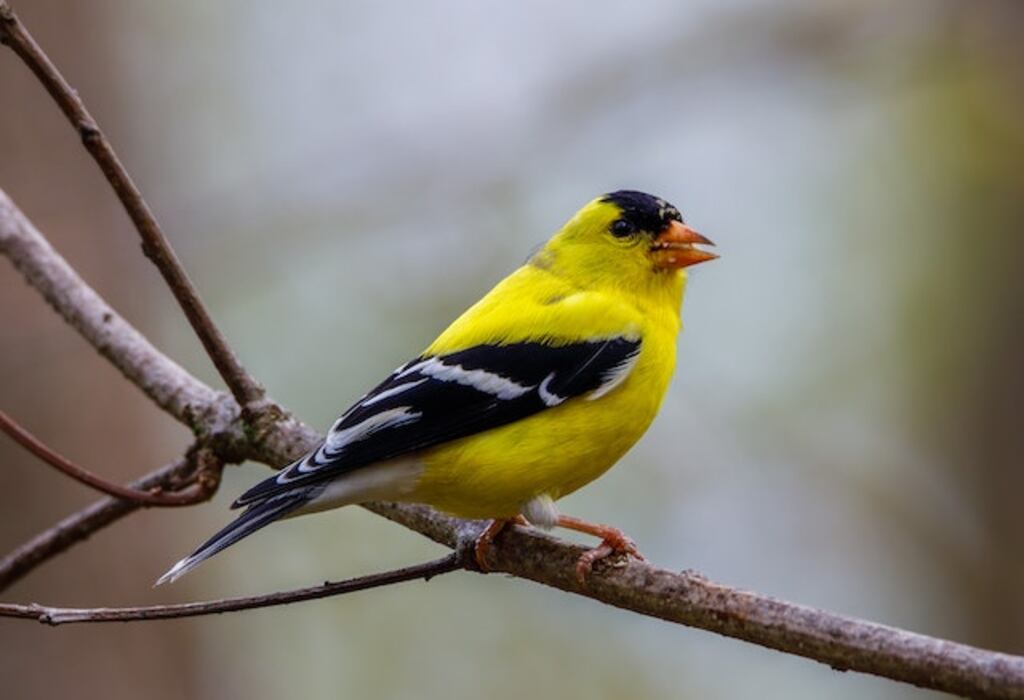Looking to learn about the New Jersey state bird? Well, look no further! In this article, we’ll dive into the fascinating history of this iconic bird, from its cultural significance to its unique characteristics.
The short answer? The state bird of New Jersey is the Eastern Goldfinch, commonly known as the American Goldfinch. But there’s so much more to explore, so let’s get started!
Table of Contents
- 1 Introduction to the New Jersey State Bird
- 2 History of the New Jersey State Bird
- 3 Physical Characteristics of the Eastern Goldfinch
- 4 Habitat and Distribution of the Eastern Goldfinch
- 5 Behavior and Diet of the Eastern Goldfinch
- 6 Conservation Status and Threats to the Eastern Goldfinch
- 7 Symbolism and Cultural Significance of the Eastern Goldfinch in New Jersey
- 8 Conclusion
- 9 Frequently Asked Questions
- 9.1 How many other states have the Eastern Goldfinch as their state bird?
- 9.2 Are there any traditional or cultural uses for the Eastern Goldfinch in New Jersey?
- 9.3 What is the average lifespan of an Eastern Goldfinch in the wild?
- 9.4 How has human development affected the population of Eastern Goldfinches in New Jersey?
- 9.5 Are there any myths or legends associated with the Eastern Goldfinch in New Jersey folklore?
- 10 Conclusion
- 11 Author
Introduction to the New Jersey State Bird
So, you’re interested in learning about the New Jersey state bird? Awesome!
First, let me explain what a state bird is and why it’s significant. A state bird is a bird that’s been chosen to represent a particular state because of its unique qualities or its connection to that state’s history or culture.
Understanding this concept will give you a better appreciation for why New Jersey chose its state bird.
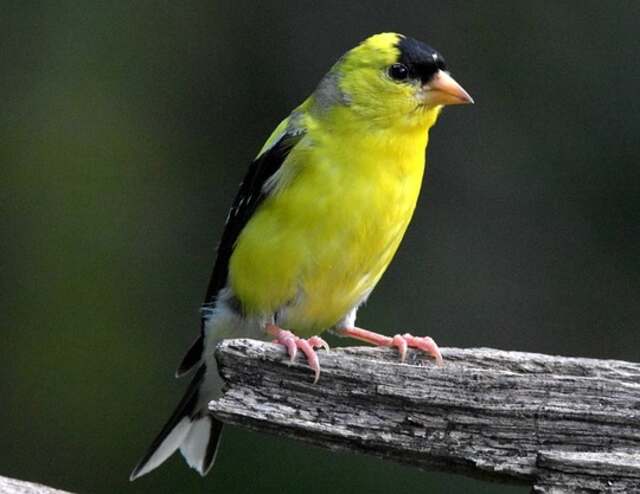
Explanation of what a state bird is and its significance
Understanding the significance of a state bird is important for appreciating the cultural and ecological values of a region.
State birds are official avian symbols chosen by each state to represent their unique identity. They’re often selected based on their cultural or ecological significance, or their historical importance to the state.
By choosing a state bird, states can showcase their pride in their unique flora and fauna, and promote the conservation of local species.
The New Jersey state bird is the Eastern Goldfinch. This small and brightly colored bird is well-known for its cheerful chirping and its love for sunflower seeds.
It was chosen as the state bird of New Jersey in 1935, due to its popularity among the state’s residents and its presence in the state’s gardens and fields.
The Eastern Goldfinch is also a symbol of the state’s agricultural heritage, as it is commonly found in fields of goldenrod and other native plants.
Brief overview of the state bird of New Jersey
The Eastern Goldfinch, chosen as a symbol of the state in 1935, can consume up to 30 sunflower seeds per minute.
This small yellow bird is also known as the American Goldfinch, and is commonly found in the eastern region of North America.
Its vibrant yellow color and black wings make it an eye-catching bird, and it is often depicted in art and literature.
Here are three interesting facts about the New Jersey state bird, the Eastern Goldfinch:
- The Eastern Goldfinch is the only finch in North America that molts twice a year, changing its feathers from a bright yellow to a dull brown in the winter months.
- The bird is often seen in fields and meadows, where it feeds on seeds from various plants such as thistle, dandelion, and sunflower.
- The Eastern Goldfinch is a migratory bird that travels to the southern United States and Mexico during the winter months, and returns to New Jersey in the spring to breed.
The habitat of the Eastern Goldfinch includes open areas with scattered trees and shrubs, as well as gardens and backyards with bird feeders. Its diet consists mainly of seeds, and it is a common visitor to bird feeders filled with thistle or sunflower seeds.
The New Jersey state bird is a beloved symbol of the state’s natural beauty and wildlife, and is often featured in local art and memorabilia.
As for the history of the state bird of New Jersey, it was chosen in 1935 by the state’s school children as part of a statewide contest to select a state bird.
The Eastern Goldfinch won by a large margin, and was officially adopted as the state bird on June 27, 1935.
Since then, it has remained a beloved symbol of New Jersey’s natural heritage.
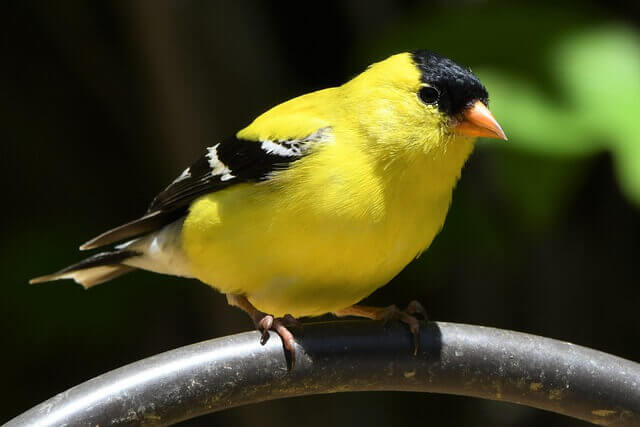
History of the New Jersey State Bird
Are you curious about the history of the state bird of New Jersey?
Let’s start with its origins. The eastern goldfinch was officially designated as the state bird in 1935, but it had been a popular symbol of the state for many years prior.
Do you know how it was chosen? The process of selecting the state bird involved a statewide vote and a committee of experts.
And finally, have you ever wondered about the historical significance of this bird? It’s not only a beloved symbol of the state, but it also represents the state’s agricultural heritage and natural beauty.
Origins of the state bird of New Jersey
It just so happens that the Eastern Goldfinch, chosen as the state bird of New Jersey, is also a popular symbol of happiness and positivity in many cultures.
This beautiful yellow bird with black wings and tail is not native to New Jersey, but it can be found throughout most of North America.
The Eastern Goldfinch is also known as the American Goldfinch, and it is the official state bird of Iowa and Washington as well.
The origins of the state bird of New Jersey go back to the early 1930s, when the New Jersey Federation of Women’s Clubs launched a campaign to select an official state bird.
The federation organized a contest that involved schools, clubs, and individuals from all over the state.
More than 90,000 votes were cast, and the Eastern Goldfinch won by a landslide, receiving 29,000 votes, almost three times as many as the second-place bird.
The selection of the Eastern Goldfinch as the state bird of New Jersey was officially adopted on June 6, 1935, by a joint resolution of the state legislature.
The process of selecting the state bird
You might be interested in learning how you can be involved in selecting your state’s official symbol, such as a bird, through campaigns and contests organized by groups like clubs, schools, and individuals.
In the case of New Jersey, the process of selecting the state bird was long and involved. The campaign to choose the official bird of New Jersey began in 1928, and it took several years for a decision to be reached.
If you’re interested in learning more about the selection process for the New Jersey state bird, there are several things you should know. Here are three key points to keep in mind:
- The decision was made through a competition: In the late 1920s, a competition was held to determine which bird would become the official bird of New Jersey. The competition was open to the public, and anyone could submit a suggestion.
- The winner was a bird with an endangered status: The bird that ultimately won the competition was the Eastern Goldfinch. While this bird is now the official bird of New Jersey, it has a somewhat precarious status in the state. It is considered an endangered species in the region, and its numbers have declined in recent years.
- The selection was made official in 1935: It took several years for the New Jersey legislature to make the selection of the Eastern Goldfinch official. Finally, on June 27th, 1935, the bird was declared the official bird of New Jersey, and it has remained so ever since.
Despite its endangered status, the Eastern Goldfinch remains an important symbol of the state’s natural beauty and wildlife.
As you can see, the selection of the New Jersey state bird was not a simple process. However, it’s a fascinating story that helps to shed light on the historical significance of this important symbol.
Historical significance of the state bird
The Eastern Goldfinch, New Jersey’s official state bird, has a rich historical significance. Native Americans used its feathers for decorative purposes, and its distinctive appearance has inspired poets and artists alike.
The bird’s bright yellow plumage and black wings make it a striking sight in the wild. Its musical chirping is also a notable feature, which adds to its charm.
The Eastern Goldfinch is also known for its resilience and adaptability. Its ability to survive in various habitats and climates has allowed it to thrive across North America.
Its unique qualities and historical significance are why it was chosen as the state bird of New Jersey. Now, let’s take a closer look at the physical characteristics of the Eastern Goldfinch.
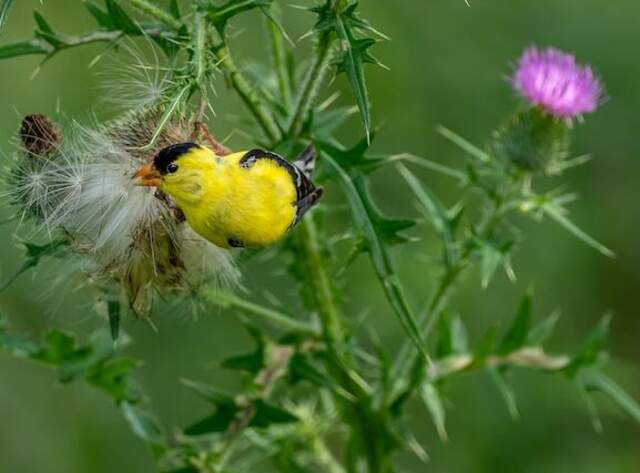
Physical Characteristics of the Eastern Goldfinch
You’ll be interested to know that the Eastern Goldfinch, New Jersey’s state bird, is a small, brightly colored bird that measures about 4.5 to 5 inches in length.
Its plumage is predominantly yellow, with black wings and tail feathers, and a black cap on its head.
One unique physical feature of the Eastern Goldfinch is its conical beak, which is specially adapted for cracking open seeds.
Description of the bird’s appearance
With its strikingly vibrant coloring and distinct long tail feathers, it’s hard to miss the new jersey state bird, the Eastern Goldfinch.
This beautiful bird is a sight to behold with its bright yellow body and black wings. Its feathers are soft and fluffy, making it an endearing sight as it flits from tree to tree.
Here is a description of the appearance of the Eastern Goldfinch, the official state bird of New Jersey:
- The male Eastern Goldfinch has a bright yellow body and black wings with white bars. Its forehead and crown are black, and it has a small black beak.
- During the breeding season, the male’s plumage becomes even brighter, almost glowing in the sunlight.
- The female Eastern Goldfinch has a less vibrant yellow body and black wings with white bars. Her forehead and crown are grayish-brown, and she also has a small black beak.
- Both male and female Eastern Goldfinches have long, slender tails that are black with white markings and a splash of yellow on the end.
With such a beautiful and unique appearance, it’s no wonder that the Eastern Goldfinch was chosen as the state bird of New Jersey.
Unique physical features of the bird
If you take a closer look at the Eastern Goldfinch, you’ll notice some unique physical features that make it stand out from other birds.
As the state bird of New Jersey, this small bird has a bright yellow body, black wings with white bars, and a black cap on its head. However, what makes this bird truly unique is its bill.
Unlike most birds, the Eastern Goldfinch has a conical-shaped bill that’s adapted for eating small seeds. Its bill is also longer and more slender than other finches, allowing it to easily access hard-to-reach seeds.
In addition to its bill, the Eastern Goldfinch also has interesting feather patterns. During the winter months, the male’s feathers become duller and less vibrant than in the summer.
This helps the bird camouflage with its surroundings and avoid predators. Furthermore, the male’s black cap becomes less prominent, making it easier for the bird to blend in with the trees it perches on.
These unique physical features make the Eastern Goldfinch a fascinating bird to observe, especially for those interested in the appearance of the New Jersey state bird.
As for its habitat and distribution, the Eastern Goldfinch can be found throughout most of North America. It prefers open fields and meadows where it can easily find seeds to eat.
During the breeding season, the bird can be found in eastern North America, from Canada to the southern United States.
However, during the winter months, the bird’s range expands to include the western United States.
Whether you’re a bird watcher or simply interested in the New Jersey state bird, the Eastern Goldfinch is a fascinating bird to learn about.
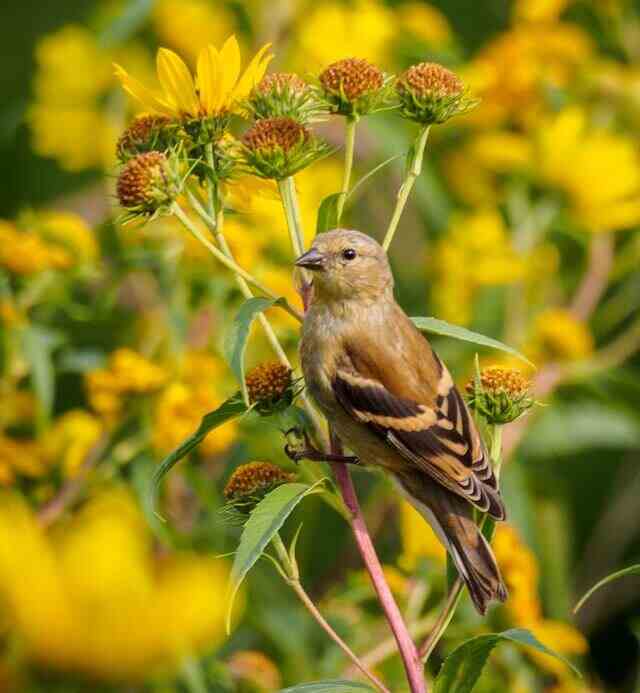
Habitat and Distribution of the Eastern Goldfinch
You’re interested in learning more about the Eastern Goldfinch, the state bird of New Jersey.
When it comes to their natural habitat, these birds prefer open fields, meadows, and weedy areas where they can easily find their favorite foods.
In terms of distribution, Eastern Goldfinches can be found throughout the eastern half of North America, from Canada down to Mexico.
As for migration patterns, these birds are considered partial migrants and may move south for the winter depending on food availability.
The bird’s natural habitat
You’ll be surprised to learn that the natural habitat of the New Jersey state bird, the Eastern Goldfinch, is quite diverse and can be found in various landscapes throughout the region.
These birds thrive in open fields, meadows, and grasslands, making them common sights in rural areas.
They are also found in suburban and urban environments, like parks and gardens, where they can easily feed on plants and flowers.
Despite being able to adapt to different habitats, Eastern Goldfinches are highly dependent on their natural habitat.
Unfortunately, their habitats are threatened by loss of open fields, meadows, and grasslands due to development and agriculture.
Conservation efforts for the New Jersey state bird are focused on protecting and restoring habitats through land conservation and management practices that benefit the birds.
By preserving and restoring their habitats, we can ensure the survival of this beautiful and active bird species in New Jersey.
As you transition into the subsequent section about geographical distribution of the bird, it’s important to note that the Eastern Goldfinch’s natural habitat is not limited to New Jersey alone.
These birds can be found in most parts of North America, from southern Canada to Mexico.
In the next section, we will explore the range of the Eastern Goldfinch and its distribution in North America.
Geographical distribution of the bird
The Eastern Goldfinch’s wide distribution across North America highlights the importance of preserving and protecting their natural habitats throughout the region.
As the state bird of New Jersey, these small birds can be found throughout the state, as well as in many other areas of the United States and Canada.
Here are a few key points to keep in mind when considering the geographical distribution of the Eastern Goldfinch:
- The bird is found in a wide range of habitats, including grasslands, meadows, fields, and open woodlands.
- Eastern Goldfinches are often seen in suburban and urban areas as well, where they can be found in parks, gardens, and other green spaces.
- These birds are known for their bright yellow plumage, which makes them easy to spot even from a distance.
As you consider the Eastern Goldfinch’s geographical distribution, it’s also worth noting their migration patterns. These birds are known for their seasonal movements, which take them to different parts of the continent depending on the time of year.
Migration patterns
If you’re interested in the New Jersey state bird, the Eastern Goldfinch, it’s important to note their migration patterns. These small birds travel across the continent depending on the season.
During the warmer months, they can be found in the northern United States and southern Canada, but as the weather gets colder, they migrate southward towards the Gulf Coast and Mexico.
Interestingly, the migration patterns of goldfinches are different from many other bird species, as they don’t follow a strict north-south migration route.
Instead, they move in a more scattered pattern, which can make it difficult to predict their movements.
During the winter months, Eastern Goldfinches in New Jersey will often form flocks and feed on seeds, including thistle and black oil sunflower seeds.
In the spring and summer, they’ll move further north to breed and feed on insects. They prefer open fields and meadows, as well as gardens and backyards with bird feeders.
Overall, the Eastern Goldfinch is an interesting bird to observe throughout the year, with their unique migration patterns and adaptable diet.
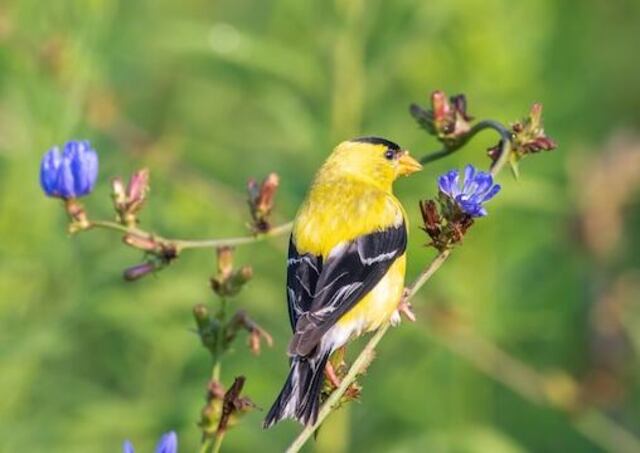
Behavior and Diet of the Eastern Goldfinch
If you’re interested in learning about the Eastern Goldfinch, you might be curious about their social behavior. These birds are typically seen in flocks, especially during fall and winter months, and they tend to stay close to one another when feeding or roosting.
As for feeding habits, the Eastern Goldfinch primarily eats seeds from plants such as thistles, dandelions, and sunflowers.
When it comes to reproduction and mating behavior, Eastern Goldfinches are monogamous and form pair bonds that last throughout the breeding season.
Males will perform courtship displays to attract females, and once they mate, the female is responsible for building the nest and caring for the eggs and chicks.
It’s fascinating to observe the behavior of these birds in their natural habitat.
Social behavior of the bird
You’ll be mesmerized by how the Eastern Goldfinch interacts with its flock, like a tightly knit community that moves and communicates as one. This isn’t surprising as it’s a social bird that thrives in groups.
The New Jersey state bird is known to form flocks of up to 50 individuals, which allows them to protect themselves from predators and share food resources.
They also have a unique way of communicating with each other through their calls and body language, which helps them coordinate their movements and stay together as a group.
The social behavior of the New Jersey state bird is not only fascinating but also essential for its survival. In addition to providing protection and food sharing, the flock also helps to find mates during the breeding season.
The birds engage in a courtship dance, where the males show off their bright yellow plumage and sing their sweet songs to attract females.
Their social behavior is thus a critical aspect of their survival, and it’s interesting to see how they work together as a community to thrive in their environment.
With such a unique social behavior, it’s no wonder why the Eastern Goldfinch is the state bird of New Jersey.
As you move on to learn about the feeding habits of the bird, you’ll discover how its diet plays a crucial role in its overall survival.
Feeding habits of the bird
As you observe the feeding habits of the Eastern Goldfinch, the state bird of New Jersey, you’ll notice that they have a varied diet consisting mainly of seeds and insects.
These little birds are known to gather their food from plants and trees, feeding on the seeds of sunflowers, thistle, and other plants.
They also feed on insects such as beetles, aphids, and caterpillars, making them an important natural pest control in gardens and farms.
Here are some key points to keep in mind when observing the feeding habits and diet of the New Jersey state bird, the Eastern Goldfinch:
- Eastern Goldfinches are primarily seed-eaters, feeding on the seeds of plants and trees.
- They also consume insects, particularly during the breeding season, when they need extra protein to feed their young.
- They are known to feed on the seeds of sunflowers, thistle, and other plants.
- They are also attracted to backyard bird feeders that contain black oil sunflower seeds.
- During the winter months, when food is scarce, Eastern Goldfinches may rely heavily on backyard feeders for survival.
As you continue to observe the Eastern Goldfinch, you’ll notice that their feeding habits are closely tied to their reproductive and mating behaviors, which we will explore in the next section.
Reproduction and mating behavior
The Eastern Goldfinch’s reproductive and mating behaviors are closely related to their feeding habits and can be fascinating to observe. These birds typically breed once or twice a year, with breeding season beginning in early summer.
During this time, the males will display their bright yellow plumage and sing complex songs to attract a mate. Once a pair has formed, they will build a nest in a shrub or tree, using plant fibers and spider webs as building materials.
The habitat of New Jersey State bird provides ample resources for the Eastern Goldfinch to thrive and breed successfully. They’re adapted to living in open areas with plenty of sunflowers and other types of wildflowers.
Once the breeding season is over, these birds will migrate south for the winter, returning to New Jersey in the spring to begin the cycle anew.
Understanding the reproductive and mating behaviors of the state bird of New Jersey is crucial for conservation efforts, as it helps to protect their natural habitat and ensure the continuation of their species.
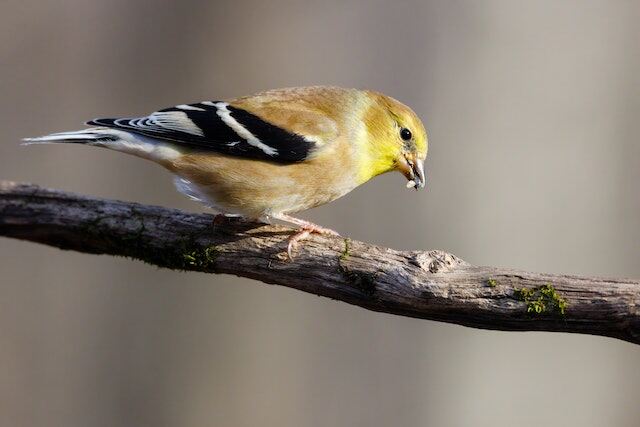
Conservation Status and Threats to the Eastern Goldfinch
To start our discussion on the conservation status and threats to the Eastern Goldfinch, let’s take a look at its current status.
The bird is currently listed as a species of least concern, meaning it’s not in immediate danger of extinction.
However, this doesn’t mean that the Eastern Goldfinch isn’t facing threats to its habitat and population.
Current conservation status of the bird
You’ll be happy to know that the Eastern Goldfinch, the official bird of New Jersey, is currently in a better conservation status compared to previous years.
This is largely due to the collective efforts of conservationists and wildlife organizations who’ve been working tirelessly to protect the bird’s habitat and reduce pollutants in the environment.
The state’s Department of Environmental Protection has also played a pivotal role in implementing conservation efforts for goldfinches. They’ve been listed as one of the endangered birds in New Jersey.
Despite the positive strides in conservation, the Eastern Goldfinch still faces threats to its habitat and population.
The bird’s natural habitat, which includes meadows, fields, and open woodlands, is being rapidly diminished by urbanization and agriculture.
Moreover, the use of pesticides and insecticides in farming practices also poses a threat to the bird’s population.
In the next section, we’ll take a closer look at the challenges that the Eastern Goldfinch continues to face and how we can work towards preserving its existence.
Threats to the bird’s habitat and population
Conservation efforts have improved the Eastern Goldfinch’s status, but challenges remain as habitat loss and pesticide use threaten its population.
As the official bird of New Jersey, the Eastern Goldfinch is a beloved species that has been the focus of many conservation efforts.
These efforts have included habitat restoration and protection, as well as education and outreach to promote awareness of the endangered status of the bird.
However, habitat loss remains a major threat to the Eastern Goldfinch. The bird’s preferred habitat is open fields and meadows, which are increasingly being developed for human use.
Additionally, pesticide use has been linked to declines in bird populations, as these chemicals can harm the birds directly or reduce the availability of their food sources.
Efforts to protect the bird and its habitat are ongoing, but will require continued cooperation and commitment from government agencies, conservation organizations, and individuals alike.
Efforts to protect the bird and its habitat
Oh, so you’re interested in how we’re saving that little yellow fluffball of feathers that everyone seems to love? Well, lucky for you, there are some pretty cool initiatives out there working hard to protect the Eastern Goldfinch and its habitat.
As the official bird of New Jersey, the Eastern Goldfinch is a beloved member of the wildlife of New Jersey.
Conservation efforts for goldfinches include habitat restoration and protection, as well as public education about the importance of preserving these beautiful creatures.
Organizations like the New Jersey Audubon Society are leading the charge in protecting the Eastern Goldfinch, working with communities to create safe spaces for these birds to nest and thrive.
With the help of dedicated volunteers and conservationists, we can ensure that the Eastern Goldfinch remains a cherished part of New Jersey’s natural heritage for generations to come.
As you can see, there are many efforts underway to protect the Eastern Goldfinch and its habitat. But why is this little bird so important to the people of New Jersey?
Well, that’s where the symbolism and cultural significance of the Eastern Goldfinch in New Jersey comes in.

Symbolism and Cultural Significance of the Eastern Goldfinch in New Jersey
You’re interested in learning about the symbolism and cultural significance of the Eastern Goldfinch in New Jersey.
As the state bird of New Jersey, the Eastern Goldfinch has been used as a symbol of the state’s natural beauty and resilience.
Its bright yellow feathers and cheerful song have also made it a beloved cultural icon for the people of New Jersey.
Use of the bird as a symbol in New Jersey
You can see the symbol of this great state everywhere, from bumper stickers to t-shirts, and it represents the unique identity and pride of the people who call this place home.
The Eastern Goldfinch, the official bird of New Jersey, has become an emblem of the state. It is a source of pride and a reminder of the state’s natural beauty.
The symbolism of the Eastern Goldfinch in New Jersey is rooted in its vibrant yellow color, which is reminiscent of the state flower, the Common Meadow Violet.
The conservation of NJ state bird is also of great importance to the people of the state. The Eastern Goldfinch is a migratory bird and is vulnerable to habitat loss and degradation.
The state has taken measures to protect the bird’s habitats and promote its conservation. The bird’s presence in the state is a testament to the state’s commitment to preserving its natural resources.
The cultural significance of the bird to the state and its people is a reflection of the state’s unique identity, history, and values.
Cultural significance of the bird to the state and its people
You’ll be surprised to know that the Eastern Goldfinch has been a source of inspiration for many artists, and its vibrant yellow color has been used in several paintings, jewelry, and clothing designs.
This cultural significance of the bird to the state and its people is not surprising, since the Eastern Goldfinch is the official bird of New Jersey.
Its selection as the state bird was based on its symbolism in the state’s history and culture.
The Eastern Goldfinch was designated as the official bird of New Jersey in 1935, and since then, it has become a symbol of the state’s spirit.
Its cheerful song and bright plumage represent the state’s sunny disposition and optimism. Furthermore, the Eastern Goldfinch is known to be a resilient bird, which symbolizes New Jersey’s perseverance in the face of adversity.
Overall, the Eastern Goldfinch’s history as the New Jersey state bird has contributed to its cultural significance and the pride of its people.

Conclusion
So, you’ve learned quite a bit about the state bird of New Jersey. To recap, the American goldfinch was designated as the state bird in 1935 due to its prevalence and vibrant coloration.
As a final thought, it’s important to note that the American goldfinch isn’t only a beautiful bird, but also a symbol of resilience and adaptability in the face of changing environments.
Recap of key points
Recapping the important details, you’ve learned about the avian symbol that represents the Garden State.
The official bird of New Jersey is the Eastern Goldfinch, also known as the American Goldfinch. They’re known for their vibrant yellow feathers, black wings, and a distinctive black cap on their heads.
These birds are small, measuring 4.3 to 5 inches in length, and weighing only 0.39 to 0.71 ounces.
Aside from their beautiful appearance, the behavior of New Jersey state bird also makes them unique. They’re known for their cheerful and playful songs, which they use to communicate with each other.
Moreover, they’re granivorous, meaning they primarily feed on seeds. They’re also one of the few bird species that can delay their breeding season until late summer when thistle and other plants produce more seeds.
Additionally, there have been conservation efforts for goldfinches in the state of New Jersey to help increase their population numbers.
In conclusion, the Eastern Goldfinch is a significant symbol for the state of New Jersey. Besides their attractive appearance, their behavior and feeding habits make them fascinating creatures.
The conservation efforts for goldfinches also show how important it is to protect and preserve the state’s natural resources, including its wildlife.
With all this in mind, let’s move on to our final thoughts on the state bird of New Jersey.
Final thoughts on the state bird of New Jersey
As the Eastern Goldfinch is known for its playful songs and delayed breeding season, it’s no wonder why this tiny bird is a bright ray of sunshine that brings hope and joy to the Garden State.
The New Jersey state bird, also known as the American Goldfinch, is a symbol of resilience and beauty.
Its bright yellow plumage stands out against the greenery of the state’s forests and meadows, making it a sight to behold.
The symbolism of the New Jersey state bird goes beyond its physical appearance.
It represents the conservation of NJ wildlife and the importance of protecting the environment.
By recognizing the Eastern Goldfinch as its official state bird, New Jersey is sending a message that it values the natural beauty of its land and is committed to preserving it for future generations.
As residents of the Garden State, it’s our duty to do our part in conserving the wildlife that makes this state so special.
Let’s continue to celebrate the Eastern Goldfinch and all of the amazing creatures that call New Jersey home.
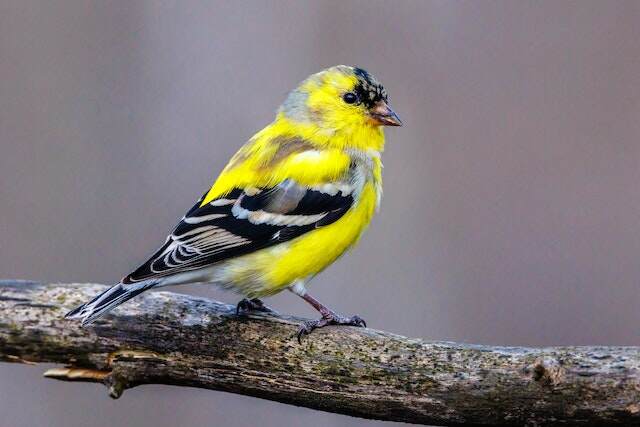
Frequently Asked Questions
How many other states have the Eastern Goldfinch as their state bird?
Did you know that the eastern goldfinch is not only the state bird of New Jersey, but also the state bird of five other states?
Connecticut, Iowa, New York, North Dakota, and Washington have all officially recognized this bright yellow bird as a symbol of their state.
The eastern goldfinch is known for its beautiful plumage, melodious song, and cheerful personality. Its resilience and adaptability make it a beloved bird across the country.
Whether you’re in New Jersey or any of these other states, keep an eye out for this delightful bird!
Are there any traditional or cultural uses for the Eastern Goldfinch in New Jersey?
If you’re wondering if there are any traditional or cultural uses for the eastern goldfinch in New Jersey, you might be interested to know that this bird is actually quite beloved in the state.
While it may not have any specific traditional or cultural significance, the eastern goldfinch is highly regarded for its beautiful coloring and cheerful song.
Additionally, many residents of New Jersey enjoy watching these birds visit their gardens and feeders, and they’re often included in local birdwatching and nature appreciation events.
Overall, the eastern goldfinch is a cherished symbol of the state’s natural beauty and wildlife.
What is the average lifespan of an Eastern Goldfinch in the wild?
Did you know that the average lifespan of an eastern goldfinch in the wild is only about 3 years?
That may seem like a short time, but these little birds make the most of it. They spend their days flitting from flower to flower, eating seeds and insects, and singing sweet songs.
Their bright yellow plumage and black wings make them a joy to watch, and they’re a common sight in gardens and fields across the country.
So next time you see an eastern goldfinch, take a moment to appreciate their brief but beautiful lives.
How has human development affected the population of Eastern Goldfinches in New Jersey?
To understand how human development has impacted the population of Eastern Goldfinches in New Jersey, you need to look at how humans have altered their natural habitat.
As developments like housing, roads, and agriculture continue to encroach on the bird’s habitat, their populations have declined.
Additionally, the use of pesticides and herbicides in agriculture has reduced the availability of food sources for these birds.
However, efforts are being made to mitigate these impacts through conservation measures like habitat restoration and the planting of native plants.
By taking these steps, there’s hope that the population of Eastern Goldfinches in New Jersey can recover and thrive once again.
Are there any myths or legends associated with the Eastern Goldfinch in New Jersey folklore?
Curious about the myths and legends surrounding the eastern goldfinch?
While some speculate that these birds hold a special significance in New Jersey folklore, the truth is that there are no confirmed stories or beliefs associated with the state bird.
Despite their lack of mythical status, eastern goldfinches are still a beloved and iconic species in New Jersey, recognized for their bright yellow plumage and cheerful songs.
So whether you’re a bird enthusiast or simply appreciate the beauty of nature, take some time to appreciate these feathered friends and all they have to offer.
Conclusion
Congratulations! You’ve learned all about the state bird of New Jersey, the Eastern Goldfinch.
This little yellow bird may seem unassuming, but it has a rich history, unique physical characteristics, and plays an important role in the ecosystem.
Next time you spot an Eastern Goldfinch flitting through the trees, take a moment to appreciate its beauty and significance.
After all, it’s not every day that you get to see a bird with such vibrant colors and a cheerful song.
You might even say it’s the most magnificent bird in all of New Jersey (okay, maybe that’s a bit of a hyperbole, but you get the point).

